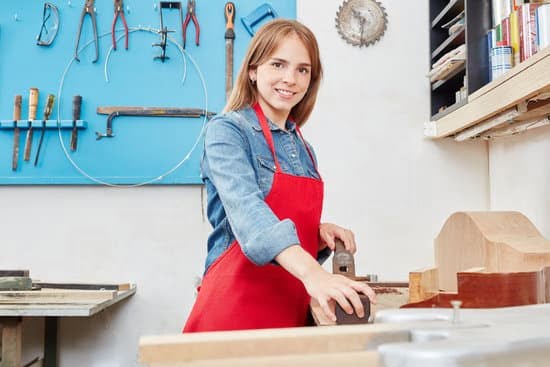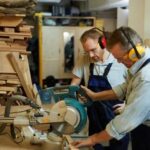Woodworking vise with bench dogs is an essential tool for anyone working on woodworking projects. Whether you are a seasoned woodworker or just getting started, understanding how to use this tool effectively can greatly improve the quality and precision of your work. In this article, we will explore the important role of bench dogs in woodworking and provide a comprehensive guide on using them with a woodworking vise.
Selecting the right woodworking vise for your specific needs is crucial in ensuring that you have a sturdy and reliable tool to work with. Once you have chosen the appropriate vise, setting it up with bench dogs is the next step. Proper setup is key to securely holding your workpiece in place so that you can make accurate cuts and measurements.
Once your woodworking vise is set up with bench dogs, it’s important to know how to properly secure your workpiece. This ensures safety and precision while working on your project. Additionally, utilizing this tool allows for making precise cuts and measurements, which is especially important for more intricate woodworking tasks.
In the following sections of this article, we will delve into maintaining and caring for your woodworking vise and bench dogs, as well as exploring advanced techniques and troubleshooting common issues that may arise during their use. By the end of this comprehensive guide, you will be equipped with the knowledge and skills needed to utilize a woodworking vise with bench dogs effectively in your woodworking endeavors.
Selecting the Right Woodworking Vise for Your Needs
When it comes to selecting the right woodworking vise for your needs, there are a few factors to consider. The type of woodworking projects you typically work on, the size of your workpieces, and the available space in your workshop all play a role in determining the best vise for you. Here are some sub-sections to help guide you through the process.
Types of Woodworking Vises
There are several types of woodworking vises to choose from, each with its own advantages and limitations. The most common types include front vises, end vises, shoulder vises, and combination vises. Front vises are typically mounted on the front edge of a workbench and are suitable for holding boards and smaller pieces.
End vises, on the other hand, are designed for holding long boards or panels horizontally. Shoulder vises are often used by cabinetmakers for joinery work, while combination vises offer versatility by combining features of different types of vises.
Considerations for Selecting a Vise
Before making a purchase, consider the size and weight capacity of the vise to ensure it can handle your typical workpiece sizes. Also think about how the vise will be mounted to your workbench – some may require specific types of mounting while others offer more flexibility.
It’s also important to consider the material and construction of the vise – heavy-duty cast iron vises can withstand heavy use and provide stability, while lighter aluminum or steel vises may be more suitable for occasional use.
Seeking Professional Advice
If you’re unsure about which woodworking vise is best suited to your needs, it may be helpful to seek advice from experienced woodworkers or professionals at your local hardware store. They can provide guidance based on their own experiences and knowledge of different types and brands of woodworking vises. Additionally, online forums and woodworking communities can be valuable resources for gathering feedback and recommendations from fellow woodworkers who have used various types of woodworking vises with bench dogs.
Setting Up Your Woodworking Vise With Bench Dogs
Understanding the Role of Bench Dogs in Woodworking
Bench dogs are small pegs that are used in conjunction with a woodworking vise to secure a workpiece during various woodworking tasks. These pegs can be adjusted to different heights and can be placed at different locations within the vise to provide stability and support for the workpiece.
Selecting the Right Woodworking Vise for Your Needs
When choosing a woodworking vise, it is important to consider the size and weight of the projects you typically work on. A larger, heavy-duty vise may be necessary for larger projects, while a smaller vise may suffice for lighter tasks. Additionally, consider whether you need a bench-mounted or portable vise based on your workspace and project needs.
Making Precise Cuts and Measurements Using a Woodworking Vise and Bench Dogs
Once your woodworking vise is set up with bench dogs, you can use them to make precise cuts and measurements. By securing your workpiece firmly in place, you can confidently use hand saws or power tools to accurately shape and cut your wood. The bench dogs will help prevent movement or shifting of the workpiece, allowing for more accurate results.
By understanding the role of bench dogs in woodworking, selecting the right woodworking vise for your needs, and learning how to properly secure your workpiece using bench dogs and a woodworking vise, you can enhance the precision and efficiency of your woodworking projects.
Properly Securing Your Workpiece With Bench Dogs and Woodworking Vise
When it comes to woodworking, properly securing your workpiece is essential to ensure safety and accuracy in your projects. This is where the combination of bench dogs and a woodworking vise becomes crucial. Bench dogs are small pegs that are placed into corresponding holes on a workbench, while a woodworking vise is a mechanical device used to secure an object to be worked on.
To use a woodworking vise with bench dogs, start by selecting the right type of vise for your needs. There are different types of vises, including front vises, end vises, and shoulder vises, each with its own advantages. Consider the size of your workpieces and the type of projects you will be working on before making a selection.
Next, setting up your woodworking vise with bench dogs involves placing the bench dogs into the pre-drilled holes on your workbench. Make sure they are secure and at the appropriate height for your workpiece. Then, position your workpiece between the bench dogs and adjust the vise to clamp it firmly in place. This will prevent any movement or slippage during cutting or shaping.
Relevant Data Table
| Woodworking Vise Types | Advantages |
|---|---|
| Front Vises | Easy to access and provide good support for wide boards. |
| End Vises | Ideal for holding long pieces of wood perpendicular to the bench surface. |
| Shoulder Vises | Great for joinery work and holding narrow boards. |
Explaining how to properly secure a workpiece using bench dogs and a woodworking vise is essential for anyone new to woodworking. It sets up beginners for success as they begin creating their own projects in the field. Once mastered, this skill will form the foundation for making precise cuts and measurements using these tools together effectively-enhancing an individual’s craftsmanship over time.
Making Precise Cuts and Measurements Using a Woodworking Vise and Bench Dogs
When it comes to woodworking, making precise cuts and measurements is essential for creating high-quality pieces. Utilizing a woodworking vise with bench dogs can greatly enhance your ability to achieve accuracy in your work. Bench dogs serve as a reliable way to secure your workpiece in place, allowing you to focus on making intricate cuts without worrying about the piece moving.
To begin using a woodworking vise with bench dogs, start by selecting the right type of woodworking vise for your specific needs. Consider factors such as the size of your workpieces, the amount of force required, and the material you will be working with. Once you have chosen the appropriate vise, it’s time to set it up with bench dogs.
Setting up your woodworking vise with bench dogs involves carefully measuring and marking the locations where you will insert the bench dogs on your workbench. It’s important to space them out evenly to ensure that your workpiece is securely held in place.
Additionally, make sure that the bench dogs are positioned at the appropriate height to accommodate the thickness of your workpiece. Once everything is properly set up, you can proceed with securing your workpiece using the woodworking vise and bench dogs.
| Woodworking Vise | Key Considerations |
|---|---|
| Type | Select one that suits your specific needs (e.g. quick-release vise, front vise, tail vise) |
| Size | Consider the size of your workpieces and available space in your workshop |
| Material | Choose a durable material such as cast iron for longevity and stability |
Maintaining and Caring for Your Woodworking Vise and Bench Dogs
Woodworking vise and bench dogs are essential tools for any woodworker, and it’s important to properly maintain and care for them in order to ensure their longevity and optimal performance. Here are some tips for maintaining and caring for your woodworking vise and bench dogs:
1. Keep your woodworking vise clean: Regularly clean the surface of your woodworking vise to remove any sawdust or debris that may have accumulated during use. Use a brush or compressed air to clean out any hard-to-reach areas, and wipe down the vise with a dry cloth after cleaning.
2. Lubricate moving parts: To keep your woodworking vise operating smoothly, make sure to regularly lubricate the moving parts with a high-quality lubricant. This will help prevent rust and corrosion, as well as reduce friction when tightening or loosening the vise.
3. Inspect bench dogs for wear: Over time, bench dogs may wear down from frequent use, affecting their ability to securely hold workpieces in place. Periodically inspect your bench dogs for any signs of wear, such as rounded edges or grooves, and replace them if necessary to ensure they continue to provide a strong grip.
4. Store your tools properly: When not in use, store your woodworking vise and bench dogs in a dry place away from moisture to prevent rusting. If possible, consider covering them with a protective layer such as wax or oil to further prevent corrosion.
By following these maintenance tips, you can ensure that your woodworking vise and bench dogs remain in top condition for years to come, allowing you to continue creating precision woodwork with ease.
Exploring Advanced Techniques and Tips for Using Woodworking Vise With Bench Dogs
When it comes to woodworking, using a vise with bench dogs can elevate your projects to a whole new level. In this section, we’ll explore advanced techniques and handy tips for getting the most out of your woodworking vise and bench dogs.
Here are some advanced techniques for using a woodworking vise with bench dogs:
- Using specialized bench dogs for different tasks, such as holdfast bench dogs for heavy duty workpieces
- Utilizing multiple bench dogs to secure irregularly shaped workpieces
- Creating custom jigs and accessories that integrate with your vise and bench dogs for specific woodworking tasks
Now, let’s delve into some tips to maximize the effectiveness of your woodworking vise and bench dogs:
- Regularly lubricate the moving parts of your vise to ensure smooth operation
- Consider adding non-slip pads or covers to your bench dogs to prevent marring delicate workpieces
- Experiment with different materials and designs for homemade bench dogs to suit various project requirements
With these advanced techniques and valuable tips, you can take your woodworking skills to the next level by harnessing the full potential of your woodworking vise with bench dogs.
Troubleshooting Common Issues When Using Woodworking Vise With Bench Dogs
In conclusion, understanding how to use woodworking vise with bench dogs is essential for any woodworker looking to secure their workpieces effectively. Selecting the right woodworking vise for your needs and setting it up properly are crucial steps in ensuring a successful woodworking process. Properly securing your workpiece with bench dogs and the woodworking vise will allow you to make precise cuts and measurements, leading to high-quality results.
Additionally, maintaining and caring for your woodworking vise and bench dogs will ensure their longevity and effectiveness. It is important to keep them clean, lubricated, and in good working condition. Exploring advanced techniques and tips for using woodworking vise with bench dogs can further enhance your woodworking skills, allowing you to take on more complex projects with confidence.
Finally, troubleshooting common issues when using woodworking vise with bench dogs is an important aspect of mastering this tool. By being aware of potential challenges and knowing how to address them, you can minimize frustration and maximize productivity in your woodworking endeavors. Overall, the proper usage of a woodworking vise with bench dogs can greatly improve the precision and quality of your work as a woodworker.
Frequently Asked Questions
What Is a Dog Used for on a Woodworking Vise?
A dog, in the context of a woodworking vise, is used as a support for holding long or irregularly shaped pieces of wood securely in place. It can be adjusted and tightened to hold the workpiece steady while it is being worked on.
Where Is the Best Place to Put a Vise on a Workbench?
The best place to put a vise on a workbench is usually along the front edge or the end of the bench. This allows for easy access and provides a stable surface for clamping down materials. Additionally, placing the vise in an area with sufficient space around it allows for flexibility in working with different sizes of materials.
Where Do You Put Dog Holes in a Workbench?
Dog holes in a workbench are usually placed in rows along the front edge and end of the bench. These holes are used to insert pegs or bench dogs that provide support and stabilizes wood pieces as they are being worked on.
It’s important to carefully measure and evenly space out these holes to ensure versatility when clamping down materials.

Hi everyone! I’m a woodworker and blogger, and this is my woodworking blog. In my blog, I share tips and tricks for woodworkers of all skill levels, as well as project ideas that you can try yourself.





